VIOLENT CRIME REDUCTION TRUST FUND
ANNUAL FINANCIAL STATEMENT
FISCAL YEAR 1995
Audit Report 97-15A, (3/97)
TABLE OF CONTENTS
OFFICE OF THE INSPECTOR GENERAL COMMENTARY AND SUMMARY
MANAGEMENT'S OVERVIEW
INDEPENDENT AUDITOR'S REPORT ON THE PRINCIPAL
FINANCIAL STATEMENTS
INDEPENDENT AUDITOR'S REPORT ON INTERNAL CONTROL
INDEPENDENT AUDITOR'S REPORT ON COMPLIANCE
COMBINED PRINCIPAL FINANCIAL STATEMENTS:
STATEMENT OF FINANCIAL POSITION
STATEMENT OF OPERATIONS AND CHANGES IN NET
POSITION
STATEMENT OF CASH FLOWS
STATEMENT OF BUDGETARY RESOURCES AND ACTUAL EXPENSES
COMBINING PRINCIPAL FINANCIAL STATEMENTS:
STATEMENT OF FINANCIAL POSITION
STATEMENT OF OPERATIONS AND CHANGES IN NET
POSITION
STATEMENT OF CASH FLOWS
STATEMENT OF BUDGETARY RESOURCES AND ACTUAL
EXPENSES
NOTES TO THE PRINCIPAL FINANCIAL STATEMENTS
APPENDIX I - INDEPENDENT AUDITOR'S REPORTS ON THE
IMMIGRATION AND NATURALIZATION SERVICE COMPONENT
APPENDIX II - ACTING CHIEF FINANCIAL OFFICER'S
COMMENTS ON THE REPORT
APPENDIX III - AUDIT DIVISION ANALYSIS AND SUMMARY
OF ACTIONS NECESSARY TO CLOSE THE REPORT
OFFICE OF THE INSPECTOR GENERAL
COMMENTARY AND SUMMARY
This audit report contains the Annual Financial Statement of the Violent Crime
Reduction Trust Fund (VCRTF) for the fiscal year ended September 30, 1995. The report
includes management's overview, the principal financial statements, and notes to the
principal financial statements, in addition to the independent auditor's reports on the
principal financial statements, internal control, and compliance with laws and
regulations.
The Chief Financial Officers (CFO) Act of 1990 requires an annual financial statement
audit of the VCRTF. The Office of the Inspector General (OIG) contracted with Williams,
Adley & Company LLP and Brown & Company, Certified Public Accountants, to perform
the audit of the FY 1995 financial statements. The audits were conducted in accordance
with generally accepted government auditing standards and Office of Management and Budget
Bulletin No. 93-06 "Audit Requirements for Federal Financial Statements." The
OIG also performs an oversight role in the audit process and ensures compliance with the
CFO Act by monitoring the progress of the audit, reviewing supporting workpapers,
coordinating the issuance of reports, and following up on findings and management letter
issues.
Reporting Entity
The Violent Crime Control and Law Enforcement Act of 1994 (Act) provides resources for
prisons, 100,000 additional police officers, and prevention programs designed with
significant input from experienced police officers. The Act also provides resources to
combat crime problems caused by criminal aliens. The Act established the VCRTF to finance
public safety and community policing programs and to supplement funding for state and
local law enforcement, corrections, and violence prevention programs. The VCRTF also
finances immigration enforcement, expedited deportation of criminal aliens, and asylum
reform.
The VCRTF received $2.3 billion in funding for FY 1995, which funded the newly
established Office of Community Oriented Policing Services (COPS) and provided
supplemental funding to support programs at the Office of Justice Programs (OJP),
Immigration and Naturalization Service (INS), Executive Office for Immigration Review
(EOIR), Civil Division, and United States Attorneys' Offices. The COPS and OJP VCRTF
funding primarily supports grant programs. Funding provided to the other offices supports
immigration initiatives.
Annual Financial Statements
The preparation of the Annual Financial Statement is the responsibility of the VCRTF's
management. The VCRTF's financial and program results are discussed in the report as part
of management's overview section. The overview was reviewed by the OIG and independent
external auditors for completeness, existence, and consistency with the principal
financial statements.
Independent Auditor's Reports
The audit resulted in a disclaimer of opinion on the principal financial statements
because of the conditions identified by the auditors while at the INS. While the INS is
only one of several components of the VCRTF, its assets and revenues are material to the
VCRTF as a whole.
The accompanying reports on the internal control structure identified material
weaknesses with respect to the grant management system, accounts payable, and at INS, fund
balance with treasury reconciliation process, financial reporting, and the financial
management control environment. The accompanying reports on compliance with laws and
regulations did not identify any material weaknesses. Certain conditions involving the
internal control structure and its operations were noted by the independent auditors and
will be communicated, under separate letter, to management. Both CPA firms also reviewed
management's process for evaluating and reporting on internal controls and accounting
systems as required by the Federal Managers' Financial Integrity Act (FMFIA), and compared
the agency's most recent FMFIA reports with the evaluation they conducted of the VCRTF's
internal control structure. The auditors were not contracted to perform control testing
sufficient to enable them to express an opinion on the internal control structure or
compliance with laws and regulations. Accordingly, they did not express such an opinion.
Financial and Other Operating Highlights
VCRTF expenses for FY 1995 totaled $326.8 million. Approximately 46 percent of total
expenses were for grant awards. Funded expenses for personnel services and benefits
totaled $43.7 million, or 13 percent of total expenses. The remaining expenses included
travel and transportation, rent and utilities, printing, supplies and materials,
non-capitalized equipment, depreciation and other items.
Grant Programs
Total expenses for grant programs were $184.5 million. Approximately 82 percent of the
total grant program expenses were for grant awards. The remaining expenses for personnel
services and benefits, travel and transportation, rent and utilities, printing, supplies
and materials, non-capitalized equipment, depreciation, and other expenses, were necessary
to establish COPS and several OJP grant programs and permit proper administration of
grants.
Grants through the COPS' "Cops on the Beat" program were expected to fund a
targeted 21,353 police officers by the end of FY 1995 in line with deploying 100,000
police officers by the end of FY 2000. According to COPS, the program exceeded the target
and funded 25,891 positions.
Immigration
Total expenses for VCRTF immigration initiatives were $142.3 million: 27 percent for
personnel services and benefits, 26 percent for non-capitalized equipment and supplies, 33
percent for contractual services, and 14 percent for other operating expenses such as rent
and travel.
Management's Overview
INTRODUCTION
The Violent Crime Control and Law Enforcement Act of 1994 (Act), Public Law 103-322,
108 Stat. 1796, represents the bipartisan product of six years of hard work. The Act is
the largest crime bill in the history of the United States and provides resources for
prisons, 100,000 additional police officers, and prevention programs designed with
significant input from experienced police officers. The Act also provides resources to
eliminate crime problems caused by criminal aliens. The real strength of this crime bill
lies in the partnership created between the Federal Government, states, cities, towns,
Indian tribes, and rural areas across America. This Act's balance of policing, punishment,
and prevention will help forge a public safety partnership that can help curtail crime
nationwide.
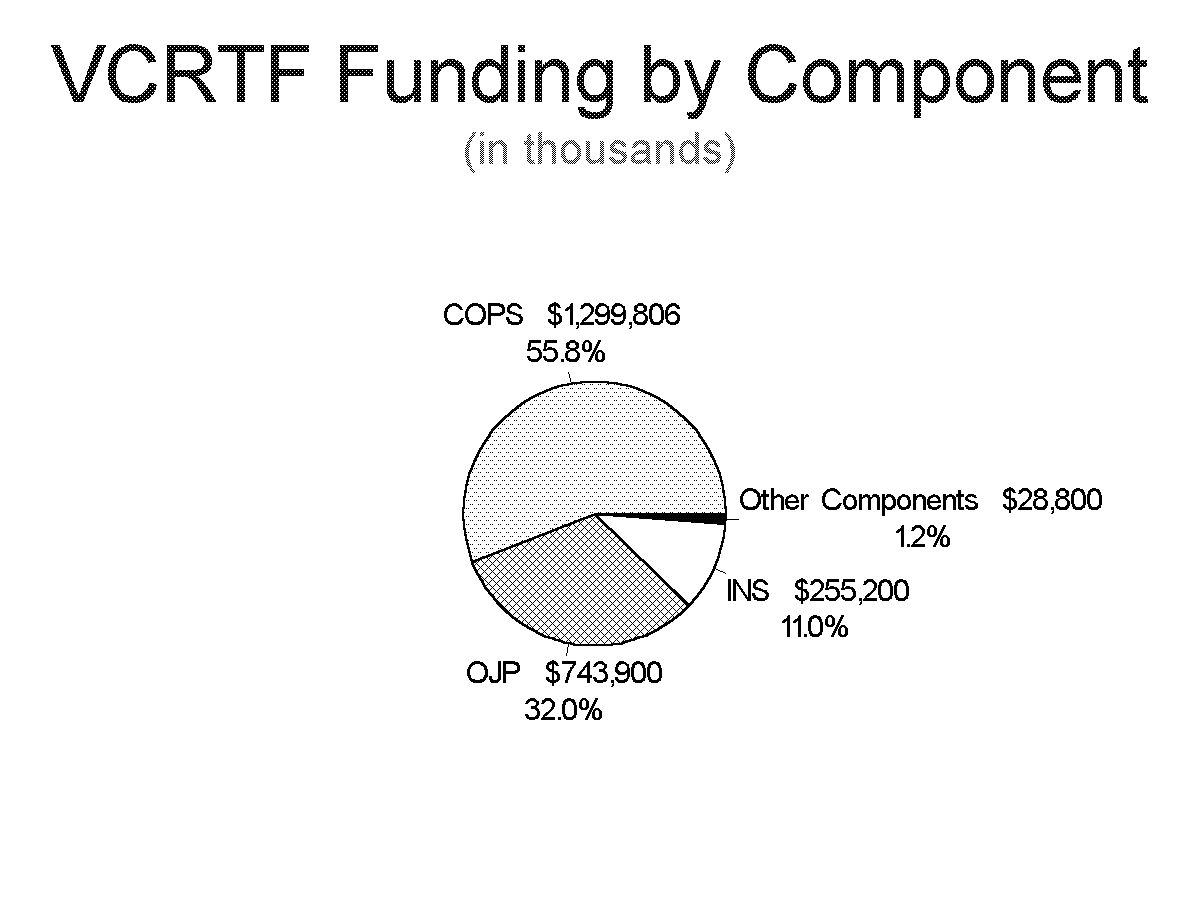
The Act established the Department of Justice (DOJ) Violent Crime Reduction Trust Fund
(VCRTF), to finance Public Safety and Community Policing Programs and to supplement
funding for State and Local Law Enforcement, Corrections, and Violence Prevention
Programs; Immigration Enforcement; Expedited Deportation of Criminal Aliens; and Asylum
Reform.
Through the Violent Crime Control Appropriations Act of 1995, Public Law 103-317, 108
Stat. 1724, the DOJ VCRTF received $2.3 billion in funding for FY 1995 which established
the Office of Community Oriented Policing Services (COPS) and provided supplemental
funding to support programs at the Office of Justice Programs (OJP), Immigration and
Naturalization Service (INS), Executive Office for Immigration Review (EOIR), Civil
Division, and United States Attorneys' Offices. The COPS and OJP VCRTF funding primarily
supports grant programs. Funding provided to the other offices supports immigration
initiatives.
GRANT PROGRAMS
Office of Community Oriented Policing Services
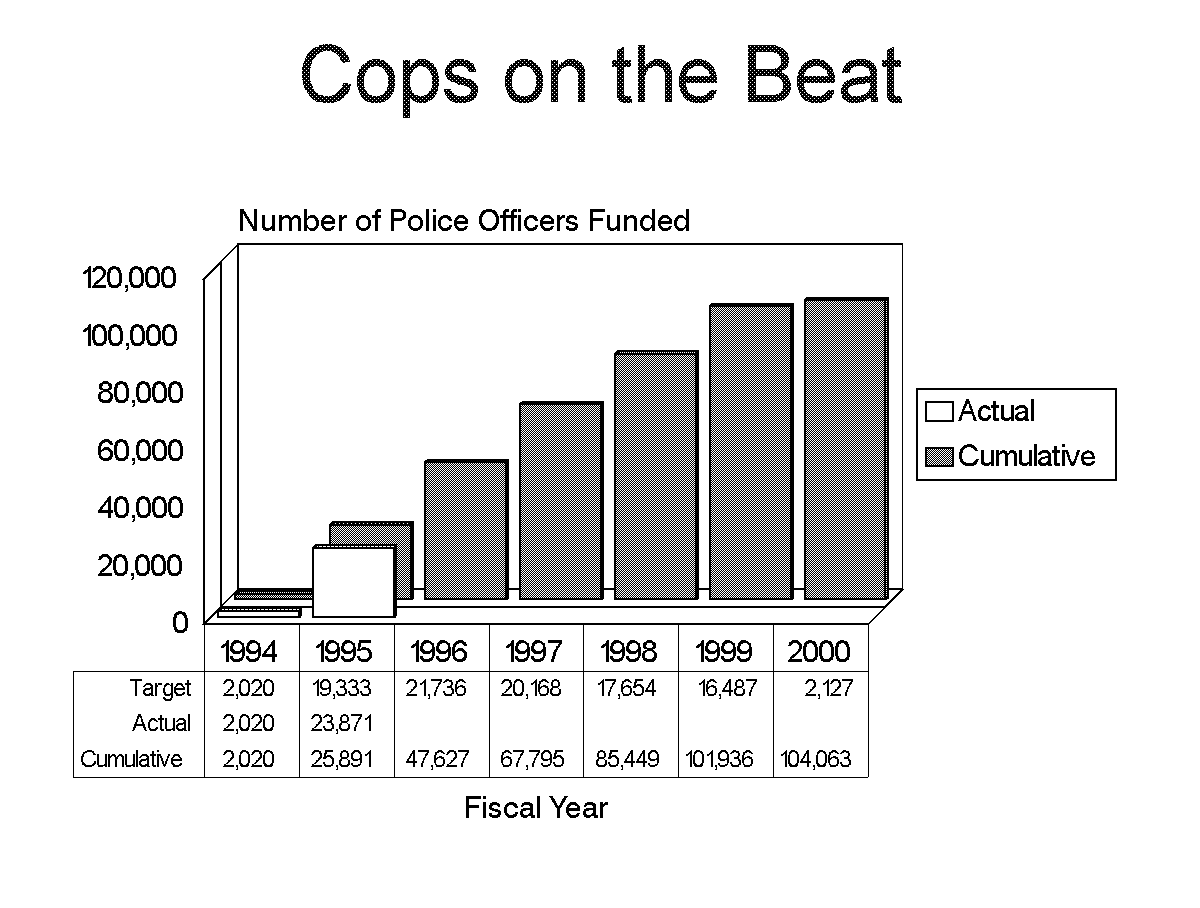
COPS was established in FY 1995, as an office within the DOJ, to implement the "Cops
on the Beat" program. The program mission is to: 1) deploy 100,000 additional
police officers in community policing roles by the end of FY 2000--a 17 percent increase
above FY 1994 levels; 2) advance the philosophy of community policing as a national law
enforcement strategy; 3) reinforce partnerships with state and local law enforcement that
will sustain the national law enforcement strategy; and, 4) evaluate and demonstrate
the effectiveness of community policing.
COPS received approximately $1.3 billion1 of VCRTF
funding in FY 1995 and established three program areas to carry out its mission: COPS
Hiring Programs, COPS Innovative Programs, and COPS Training, Technical Assistance, and
Evaluation.
COPS Hiring Programs. In FY 1995, COPS worked closely with OJP's Bureau of
Justice Assistance (BJA) to complete the initial round of COPS Phase I grant awards ($200
million) for police hiring, utilizing unfunded applications previously submitted under the
Police Hiring Supplement that was funded through an FY 1993 supplemental appropriation.
COPS also implemented the following four grant programs to assist state, local, and tribal
agencies in their efforts to adopt a community policing framework, reduce fear of crime,
and improve the quality of life for the communities they serve. Funds granted are not to
exceed 75 percent of the total costs of the grantee program or activity supported, unless
a waiver is granted. In addition, grants may not exceed $75,000 per newly hired officer.
- COPS AHEAD (Accelerated Hiring, Education, and Deployment). Designed to serve
jurisdictions with populations of 50,000 or more, this program was announced in October
1994 and enabled interested state and local law enforcement agencies to begin recruiting
and hiring new officers, prior to the submission of a formal grant application. Six
hundred and thirty two jurisdictions were given authorization on December 18, 1994, to
hire up to 2.5 percent of their October 1 sworn force level. Over 500 of the agencies
formally applied and received funding to continue their plans to deploy over 4,000
officers into community policing activities.
- COPS FAST (Funding Accelerated for Smaller Towns). This program was announced in
November 1994 as a hiring program targeted at police agencies serving jurisdictions with
fewer than 50,000 in population. On February 8, 1995, 6,600 jurisdictions were selected to
receive COPS FAST funding, supporting over 7,000 officers.
- COPS MORE (Making Officer Redeployment Effective). This program was announced in
December 1994 and funds equipment, technology, civilian hiring and overtime pay to
redeploy current law enforcement officers into active community policing, instead of
hiring additional law enforcement officers.
- COPS Universal Hiring Program. Announced in June 1995, this program was established as
an ongoing funding vehicle for state and local law enforcement agencies that had not yet
received COPS resources and applicants seeking to start a new department. There are no
population restrictions and the program has multiple application opportunities.
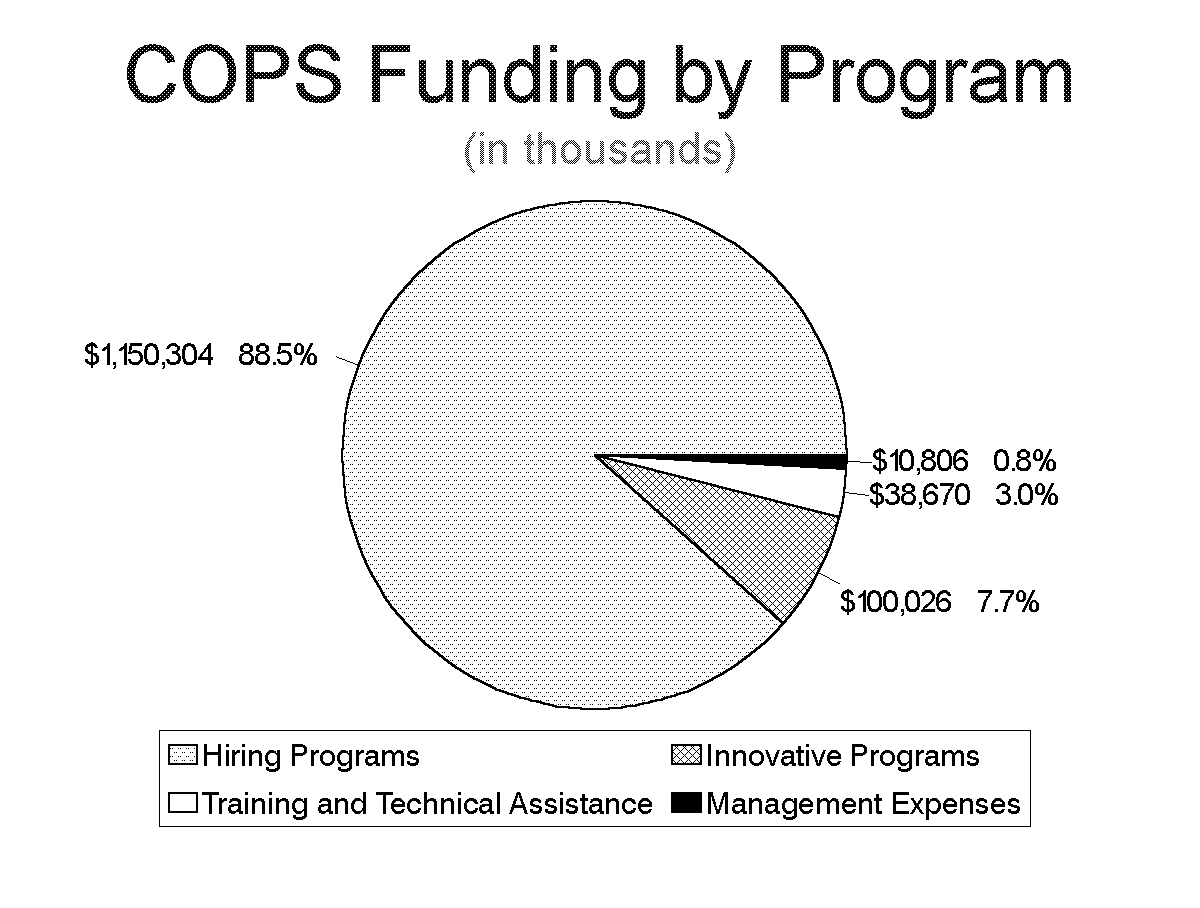
At least 85 percent of the grants under the COPS funding must be applied to the hiring,
rehiring, and redeployment of officers for community policing; procuring equipment and
technology; or payment of overtime. The remaining 15 percent or less of the grants are
aimed at assisting the COPS Hiring Programs through technical assistance and training and
programs to combat youth and domestic violence.
At the end of FY 1995, a total of 13,527 applications for COPS Hiring Program grants
were received, and 7,238 grants were awarded, making $1.139 billion available to state and
local law enforcement agencies across the country for the hiring of 23,871 police
officers. Approximately 91 percent of the awardees accepted grants, and the expectation is
that communities maintain the officers hired after the period of Federal funding expires.
During FY 1995, COPS provided thousands of state and local law enforcement agencies
with information about grant programs, research summaries, training opportunities, and
community policing strategies, by maintaining a mailing list of 70,000 law enforcement
agencies, city and state officials, and interested citizens. Approximately 82 percent of
the U.S. population was reached, directly or indirectly, by the COPS Hiring Program during
FY 1995.
COPS Innovative Programs. COPS Innovative Programs encompass a series of
non-hiring community policing initiatives. During FY 1995, several types of Innovative
Programs were developed.
- Youth Firearms Violence Initiative. This initiative was established by COPS in June 1995
to fund targeted enforcement efforts in 10 United States cities to combat the rise of
youth firearms violence. The initiative encourages innovative approaches aimed at reducing
the number of firearms-related drug offenses and violent firearms crimes committed by
youths and gangs. A total of $8.6 million for FY 1995 was funded to the following targeted
cities: Baltimore, MD; Birmingham, AL; Bridgeport, CT; Cleveland, OH; Inglewood, CA;
Milwaukee, WI; Richmond, VA; Salinas, CA; San Antonio, TX; and Seattle, WA. Because of the
desire to replicate successful efforts pioneered through this initiative, funding was
given to the National Institute of Justice (NIJ) to conduct a multi-site evaluation of the
enforcement efforts being tested. This evaluation is scheduled to be completed in FY 1997.
- Community Policing to Combat Domestic Violence. COPS, in conjunction with DOJ's Violence
Against Women Office, established in March 1995, also undertook the Community Policing to
Combat Domestic Violence project. The initiative provides a unique opportunity for law
enforcement agencies to execute well-planned, innovative strategies by focusing on one of
three areas: training, problem solving, or changing police organizations. The hallmark of
this one-year program is that local law enforcement must partner with non-profit,
non-governmental victim service programs, domestic violence shelters, or community service
groups to apply for funding under this solicitation. This program was announced in
September 1995, and the deadline to apply was November 1995. Total funding available for
these grants was $20 million in FY 1995, and $45 million overall.
- Comprehensive Communities Program (CCP) and Community Policing Demonstration Projects.
COPS collaborated with other DOJ components to develop the Comprehensive Communities
Program and the Community Policing Demonstration Projects. The purpose of CCP, started in
the summer of 1994, is to encourage the development and implementation of comprehensive
crime control and crime prevention strategies by communities faced with high rates of
violent and drug-related crime. Sixteen jurisdictions were awarded CCP grants by BJA. In
FY 1995, COPS entered into an agreement with BJA to provide $10 million to fund the
community policing component of ten of the sites. In FY 1995, COPS also agreed to provide
$819,000 in second-year continuation funding to four participants in BJA's Community
Policing Demonstration Projects. Fourteen law enforcement agencies across the country have
been selected by BJA as demonstration sites based upon their progress in implementing
community oriented policing in their jurisdictions. The lessons learned from these sites
in the implementation and further development of community-oriented policing will provide
timely and useful information to policy makers and practitioners nationwide who are
considering initiating or further refining community policing in their own jurisdictions.
- Community Policing Initiatives Focused on Empowerment Zones. Community Policing
Initiatives Focused on Empowerment Zones involves COPS, the Office of Juvenile Justice and
Delinquency Prevention and the Community Relations Service. The focus of this project is
to develop and field-test a youth-focused community policing training and technical
assistance package to be offered to several of the Empowerment Zones and Enterprise
Communities2 nationwide. During FY 1995, a management
team was formed by the three agencies and regular meetings were held to develop the
parameters of this initiative.
COPS Training and Technical Assistance. COPS began to develop a broad range of
training programs to accelerate the growth of community policing through innovative
training designed to change training curricula and delivery, and redirect the focus of
police-community partnerships and programs to meet the unique needs of community policing.
These programs include the following:
- Training Curriculum Development. Designed to fund state training commissions that fully
integrate community policing principles into the police curricula mandated by the state
and train in-service instructors to work with the new curricula.
- Statewide Training Delivery. Will target funding of innovations that will expand
training delivery systems to accelerate the growth of community policing training. These
programs will provide statewide community policing training and use technology to
disseminate information to those with limited access to training.
- Multi-State Regional Training. This program will extend the community policing training
knowledge base across the country by networking with states to partner them with other
states in their region.
- Multi-Cultural Awareness Training. Designed to fund innovative models of multi-cultural
awareness training that will contribute to the development of effective partnerships with
all segments of the community.
- Community-Based Training. Will fund a broad range of training programs designed to
sustain community policing gains and support training that strengthens community-police
partnerships.
COPS provided nationwide training through the Community Policing Consortium (CPC). The
CPC was established and originally funded by the BJA and is a joint effort of the
International Association of Chiefs of Police, the Police Foundation, the Police Executive
Research Forum, the National Sheriffs' Association, and the National Organization of Black
Law Enforcement Executives. During FY 1995, COPS entered into a Cooperative Agreement with
the CPC. COPS will supplement nationwide training provided by the CPC by supporting the
Law Enforcement Coordinating Committees, United States Attorneys' Offices, and their law
enforcement working groups to develop cadres of community policing specialists to provide
supplemental statewide training and technical assistance. A range of training forums will
be sponsored, including regional conferences, workshops, seminars, "train the
trainer" sessions for on-site technical assistance, and site-specific training for
individual police departments with unique training needs.
Office of Justice Programs
The OJP provides Federal leadership in identifying emerging criminal justice issues,
developing and testing promising approaches to these issues, evaluating program results,
and disseminating findings and other information to state and local governments. The OJP
formulates and coordinates policy and helps focus agency-wide efforts on program
priorities, including those funded through the VCRTF.
During FY 1995, OJP received $743.9 million from the VCRTF to fund seven programs:
State and Local Law Enforcement Assistance, State Criminal Records Upgrade, State Criminal
Alien Assistance Program, Correctional Facilities/Boot Camps, Drug Courts, Violence
Against Women Act Grants, and President's Prevention Council. The OJP receives other
appropriations from Congress to fund personnel costs and other programs.
State and Local Law Enforcement Assistance. For FY 1995, $450 million from the
VCRTF funded OJP's Edward Byrne Memorial State and Local Law Enforcement Assistance
Program. By the end of FY 1995, $443.8 million of the $450 million was designated for
payment to grantees. Formula grants awarded under this program are intended to reduce and
prevent crime and violence; improve the functioning of the criminal justice system at the
state and local levels, with special emphasis on multijurisdictional efforts to control
drugs and related violent crime; and support national drug control priorities. An
estimated 100,000 drug arrests nationwide are attributed in part to grant-funded
multijurisdictional task forces. Many of these units focus on high-level offenders, and
most involve Federal, state, and local agencies working together daily.
Following are other notable accomplishments in law enforcement assistance achieved
during FY 1995:
- Nearly all of the 56 participating states and territories used their Byrne formula
grants to implement programs in national priority areas such as community-based programs.
- Programs such as Drug Abuse Resistance Education (DARE) and other drug prevention and
education projects, as well as domestic violence reduction and system response
initiatives, continued with strong community-based support.
- The BJA staff approved state applications within 45 days of receipt and provided
training in proper administration of the program to nearly 200 state agency staff.
Criminal Record Upgrade. The National Criminal History Improvement Program
(NCHIP), an ongoing OJP program, received $100 million from the VCRTF during FY 1995. The
major goals of the NCHIP, administered by OJP's Bureau of Justice Statistics, are to
improve the quality of criminal history records and to develop a nationwide capability to
perform timely and accurate criminal background checks. These goals directly support
implementation of the Brady Handgun Violence Prevention Act and the National Child
Protection Act of 1993. Because of the nearly identical purposes of the two Acts, DOJ
endorsed the issuance of a single program initiative in order to ensure uniformity in all
grant activity intended to improve criminal history records.
The goal of record enhancements is to permit the immediate identification of persons
who are not authorized to purchase a firearm or to hold positions of responsibility
involving children, the elderly, or the disabled. Similarly, enhanced records can be used
to directly support law enforcement decisions regarding pretrial release, career criminal
charging, sentencing options, and correctional assignments. Program activities during FY
1995 that supported the Criminal Records Upgrade initiative are as follows:
- The Federal Bureau of Investigation (FBI) began startup tasks related to its role in the
National Instant Criminal Background Check System (NICS). NICS is an index of automated
records maintained by the states. The proportion of state records that are currently
automated is approximately 78 percent. This automation upgrade is a crucial process
that must continue steadily if NICS is to become functional by November 1998, as specified
in the Brady Act.
- Grant awards were made to 44 states that have approximately 86 percent of the nation's
criminal history records. These funds are for acquiring equipment, and developing
procedures to automate criminal records that are complete, accurate and available to NICS.
- The number of states participating in the Interstate Identification Index (III) is 30.
Participation in the III program ensures that each state system will meet the standards
established by the FBI for sharing records nationwide. The remaining 20 states are in
varying stages of development of these standards.
State Criminal Alien Assistance Program. To reimburse states for some of the
costs of incarcerating illegal aliens convicted of felony offenses, $130 million of VCRTF
resources were provided for this program during FY 1995. The grant portion of this program
is administered by the BJA, which processes applications from the eligible states and
verifies the average inmate costs being incurred. The INS is responsible for verifying the
immigration status of inmates on reimbursement claims.
A preliminary series of awards totaling $42.9 million was made to the seven states with
the largest populations of incarcerated criminal aliens: Arizona, California, Florida,
Illinois, New Jersey, New York, and Texas.
Correctional Facilities Grants. This program, which is administered by OJP,
provides grants to states to assist them in making more secure space available for violent
offenders and to implement truth in sentencing laws. During FY 1995, $24.5 million of
VCRTF funds was made available for discretionary grants to states and units of local
government for the planning, renovation, and construction of boot camps. Boot camp
facilities for nonviolent offenders free conventional prison, jail, and juvenile
corrections space for the confinement of violent offenders.
In addition to providing physical training and strict discipline, boot camp programs
address offender rehabilitative needs through substance abuse treatment/education,
literacy training, cognitive development, family preservation, victim awareness, and
anti-violence strategies. Community re-entry and aftercare are also important program
components designed to monitor and support the offender as he or she returns to the
community. During FY 1995, OJP implemented technical assistance and evaluation programs to
assist the grantees with implementation of boot camp programs and to monitor their
effectiveness.
During FY 1995, $23.1 million was designated to fund 44 projects in 28 states and
3 territories. Boot camp planning activities have been initiated at 27 sites. Seven sites
are renovating and expanding existing facilities and 10 sites are constructing new boot
camp facilities. Over half of the facilities will serve juvenile offenders. Nineteen of
the boot camps will be operated by units of local government and two by Indian Tribes.
Drug Courts. This new initiative seeks, over the long term, to provide grants
and technical assistance to improve public safety and reduce criminal recidivism through
intensively supervised treatment for drug-addicted, non-violent offenders. The goal of
this initiative is to provide an integrated mix of treatment, substance abuse testing, and
sanctions to break the cycle of substance abuse and crime. This initiative, administered
by the Drug Courts Program Office, which was created within OJP early in FY 1995, received
$11.9 million from the VCRTF for FY 1995.
Early in FY 1995, the program office addressed administrative matters to help ensure
the efficient and effective issuance of grants. In March 1995, OJP, in close coordination
with the Department of Health and Human Services, published the program's guidelines and
application material. The program received 130 applications from 41 states, Puerto Rico,
and the District of Columbia. In August 1995, 52 planning grants were issued, and in
September 1995 the Attorney General announced the award of five implementation grants and
eight enhancement grants.
Also during FY 1995, the Drug Courts Program Office, in consultation with other
agencies and resources, developed a unique technical assistance approach using peer
professionals and "mentor courts" to assist grantees in the development of
effective local programming. The office, in cooperation with the NIJ, also hosted a
national planning session to provide valuable assistance in the development of the
national Drug Court evaluation initiative.
Violence Against Women Act Grants. Another new initiative supported with VCRTF
resources and administered by OJP is the STOP (Services, Training, Officers, Prosecutors)
Violence Against Women Formula Grant Program. This program is designed to develop and
enhance effective law enforcement and prosecution strategies to combat violence against
women and also to create and expand the array of services for victims of such violence.
The program encourages states and localities to restructure the criminal justice response
to be proactive in addressing violence against women. It is designed to promote a new
dialogue among law enforcement officials, prosecutors, and victim service providers to
create an integrated criminal justice system response to the needs of battered and
sexually assaulted women.
In FY 1995, $26 million from the VCRTF was provided for this program. To receive
funding under this program, states and territories were required to certify that: (1) they
or another level of government would incur the full out-of-pocket costs for forensic
medical examinations for sexual assault victims; and (2) their laws, policies, or
practices do not require that a victim bear either the costs associated with filing
criminal charges against a domestic violence offender or the costs associated with the
issuance or service of a warrant, protection order, and/or witness subpoena in connection
with the prosecution of any misdemeanor or felony domestic violence offense. The Violence
Against Women Act stipulates that the states and territories must be in compliance with
this second condition by September 13, 1996, or the end of the next legislative session,
whichever is later.
All 56 states and territories complied with these requirements and were awarded grants
in early June 1995. In addition, 14 grants totaling approximately $1 million were
awarded to Indian tribal units in September 1995, as stipulated by the Violence Against
Women Act.
President's Prevention Council. Title III of the Act created the Ounce of
Prevention Council. This Council, chaired by the Vice President, includes the Attorney
General; the Secretaries of Education, Health and Human Services, Housing and Urban
Development, Labor, Agriculture, Treasury, and Interior; and the Director of the Office of
National Drug Control Policy. It is responsible for developing a comprehensive crime
prevention catalogue, providing assistance to communities and community-based
organizations seeking information regarding crime prevention programs and integrated
program service delivery, and developing strategies for program integration and grant
simplification.
During FY 1995, the Council received $1.5 million from the VCRTF. The Council opened an
office in February 1995. As one of its first projects, the Council with the assistance of
the OJPs' Office of Juvenile Justice and Delinquency Prevention published a catalog of
Federal crime prevention programs, titled, Preventing Crime and Promoting
Responsibility: 50 Federal Programs That Help Communities Help Their Youth. This
catalog was designed to support community-based efforts to prevent youth crime and
violence. The Council and the Department of Housing and Urban Development announced a $1.2
million grant program to help coordinate youth development and crime prevention programs
in Federally designated Empowerment Zone and Enterprise Community areas.
IMMIGRATION
The Act contains specialized enforcement provisions regarding immigration and criminal
aliens. Four components at the Department are tasked with the responsibility of addressing
the provisions pertaining to border control, criminal alien deportation, and asylum
reform. Below is a brief description of each of these components followed by a description
of their combined efforts to address these provisions.
Immigration and Naturalization Service. INS' mission is to deter and prevent
illegal entry into the United States; to locate and apprehend aliens and other illegal
entrants at or near the border; and to admit through established land, air and sea
ports-of-entry travelers qualified for entry. The agency enforces immigration laws within
the country and apprehends, detains and removes criminal aliens and other aliens found to
be deportable or inadmissible. INS also administers the nation's asylum program.
United States Attorneys' Offices. The United States Attorneys serve as the
nation's principal litigators under the direction of the Attorney General. They conduct
most of the trial work in which the United States is a party. They are responsible for the
prosecution of criminal cases brought by the Federal Government; the prosecution and
defense of civil cases in which the United States is a party; and the collection of debt
owed the Federal Government which are administratively uncollectible.
Civil Division, Office of Immigration Litigation (OIL). The OIL defends the
Federal Government in Federal court against challenges to the laws, policies, and
administrative procedures that regulate the admission, activity, and removal of aliens.
This office handles and coordinates all immigration cases before the Federal district, and
circuit courts, defending not only individual challenges to enforcement actions and
removal orders, but also class actions and other suits against INS' policies and
activities.
Executive Office for Immigration Review. EOIR's mission is to provide a uniform
interpretation and application of immigration law to ensure fair treatment for all
involved parties.
Border Control
INS received $255.2 million in FY 1995 VCRTF resources to support its primary border
enforcement mission of deterring or preventing illegal entry and locating and apprehending
aliens and other illegal entrants at or near the border. During FY 1995, approximately
$157 million of the VCRTF resources was designated to address deficiencies in computer
equipment and communications infrastructure. As of September 30, 1995, INS accomplished
the following:
- Purchased approximately 2,500 narrowband, digital portable and mobile radios; 121
infrared surveillance scopes; and 8,196 sensors to support more secure and effective
patrol operations.
- Established a criminal alien lookout database of 22,000 individuals. When used in
conjunction with the IDENT system, criminal aliens, illegal entrants, and benefits
applicants in San Diego, CA, and Tucson, AZ, will be more readily identifiable. The IDENT
system is an automated fingerprint identification system which is compatible with systems
used by the FBI, and states and local agencies. Data gathered and stored in these systems
is intended to help with tracking and analyzing recidivism (repeated entry by illegal
aliens), and more importantly, help identify where additional personnel and/or operational
equipment should be deployed.
- Increased automation support to three ENFORCE system sites along the border. The ENFORCE
system will provide operation and maintenance for several existing enforcement database
management systems. The ENFORCE system initiative includes case tracking and management,
apprehension processing, positive identification, detention management, deportation and
removal, intelligence analysis, legal proceedings, and statistical and management
reporting.
Also, the hiring, training, and deployment of new border patrol agents along the
Southwest border was accelerated: 700 border patrol agents and 110 support staff were
authorized, helping to bring the total number of newly-hired agents to 1,005 in FY 1995,
resulting in an end-of-year on-board strength all-time high of 4,881. The hiring of more
support personnel enables agents to spend more time on actual "border control."
The United States Attorneys' Offices and OIL have become increasingly involved with the
litigation arising from the increase in border patrol apprehensions and undocumented
aliens contesting their immigration status. The United States Attorneys' Offices received
$6.8 million from the VCRTF in FY 1995 to hire 40 attorneys, 13 paralegals and 27
other technical support personnel. OIL received $4.6 million from the VCRTF in FY 1995, to
hire 46 attorneys, one paralegal, and 11 support staff. These personnel will assist with
the hundreds of cases being appealed as a result of the border patrol, criminal alien and
asylum reform initiatives mandated in the Act.
Criminal Alien Deportation and Asylum Reform
INS VCRTF funding of $28.6 million was designated for key improvements in asylum reform
and the expedient removal of criminal aliens: $20.8 million for additional staff for the
Asylum Program, $4.8 million for additional trial attorneys and support staff, $2.5
million for related automation initiatives, $300 thousand for removal of criminal aliens,
and $200 thousand for an increase in administrative support.
As of September 30, 1995, INS had hired 205 of the 376 new positions established for
the Asylum Program. As a result of these personnel increases and other enhancements, the
following Asylum Program goals were either met or significantly exceeded in FY 1995.
- 113,207 cases were completed -- twice the number completed during FY 1994.
- 150,666 asylum applicants were scheduled for interviews during FY 1995 (an increase of
nearly 300 percent over 1994) and 64,365 applicants were interviewed (an increase of about
200 percent over 1994).
- All offices were current with the receipt of new applications as of May 1, 1995, and
were beginning to work on backlog cases.
The VCRTF added $17.4 million of its resources to EOIR's existing asylum reform and
criminal alien adjudications programs. The asylum process was reformed by implementing
streamlined case-processing procedures, integrating INS and EOIR processes, and
eliminating duplicative adjudications. The revised procedures, which became effective in
January 1995, require that new asylum applicants receive final decisions on their claims
within 180 days of filing their applications. EOIR completed 5,932 asylum cases with 99
percent of the cases completed within 180 days of the initial filing date.
Claims that are not approved by the INS are automatically referred to EOIR's
Immigration Judges, who conduct exclusion and deportation hearings3.
Civil deportation and exclusion proceedings are also conducted in order to adjudicate the
immigration status of alien inmates who are incarcerated in Federal, state, and municipal
institutions as a result of convictions for criminal offenses. These particular
proceedings are conducted through the Institutional Hearing Program (IHP).
The IHP allows INS to assume custody of, and promptly remove, incarcerated deportable
aliens when their sentences are complete. EOIR and INS' Investigations and Detention and
Deportation programs worked together to improve and expand the IHP. The IHP is now in
place in all 50 States, Puerto Rico, the District of Columbia, selected municipalities,
and the Federal Bureau of Prisons. The number of total "removals" (both
deportations and exclusions) recorded by INS at the end of FY 1995 totaled 49,734 -- a 9
percent increase over the previous year. Of these, over 31,000 were criminal aliens. EOIR
received 15,686 new cases in FY 1995 and completed 15,690 -- of which over 93 percent were
completed prior to the alien's earliest possible release date.
The OIL reported that approximately 25 percent of its FY 1995 cases were VCRTF-related
removal cases. The OIL won 98 percent of its cases in FY 1995, contributing significantly
to the success of the overall criminal alien removal program by upholding administrative
decisions challenged in court. With the Board of Immigration Appeals expecting to decide
up to 18,000 cases per year, the OIL expects that these appeal cases will comprise a
higher proportion of its workload over the next several years.
The United States Attorneys' Offices reported over 4,042 immigration case filings in FY
1995, an increase of nearly 64.5 percent from FY 1994. Similarly, the number of defendants
in these cases increased, by 66.4 percent, to 4,634. An overall conviction rate of 93
percent was maintained for criminal cases during FY 1995, and nearly 79.3 percent of the
guilty defendants were sentenced to prison. Staff hired with VCRTF resources assisted with
this increased workload.
FINANCIAL PERFORMANCE INFORMATION
The accompanying statements and notes consolidate and summarize the VCRTF financial
position and disclose the cost of operations and changes in net position during FY 1995.
The statements also present all significant cash flows during the period and provide a
comparison of budget and actual expenses.
VCRTF expenses for FY 1995 totaled $326.8 million. Approximately 46 percent of total
expenses were for grant awards. Funded expenses for personnel services and benefits
totaled $43.7 million, or 13 percent of total expenses. The remaining expenses included
travel and transportation, rent and utilities, printing, supplies and materials,
non-capitalized equipment, depreciation and other items.
Approximately $262 million from the FY 1995 VCRTF appropriation, which was not
designated for a specific purpose in FY 1995, remains available until expended for future
VCRTF activity.
Grant Programs
Total expenses for grant programs were $184.5 million. Approximately 82 percent of the
total grant program expenses were for grant awards. The remaining expenses for personnel
services and benefits, travel and transportation, rent and utilities, printing, supplies
and materials, non-capitalized equipment, depreciation, and other expenses, were necessary
to establish COPS and several OJP grant programs and permit proper administration of
grants.
Immigration
Total expenses for VCRTF immigration initiatives were $142.3 million: 27 percent for
personnel services and benefits, 26 percent for non-capitalized equipment and supplies, 33
percent for contractual services, and 14 percent for other operating expenses such as rent
and travel.
LIMITATIONS OF THE FINANCIAL STATEMENTS
The financial statements have been prepared to report the financial position and
results of operations of the VCRTF, pursuant to The Government Management Reform Act of
1994, Public Law 103-356, 108 Stat. 3410. While the statements have been prepared from the
books and records of the DOJ in accordance with the form and content guidance specified by
the Office of Management and Budget, the statements have minor differences from the
financial reports used to monitor and control the use of VCRTF budgetary resources, which
are prepared from the same books and records.
The statements should be read with the realization that they are for a sovereign
entity, that unfunded liabilities reported in the financial statements cannot be
liquidated without the enactment of an appropriation, and that payment of all liabilities
other than contracts can be abrogated by the sovereign entity.
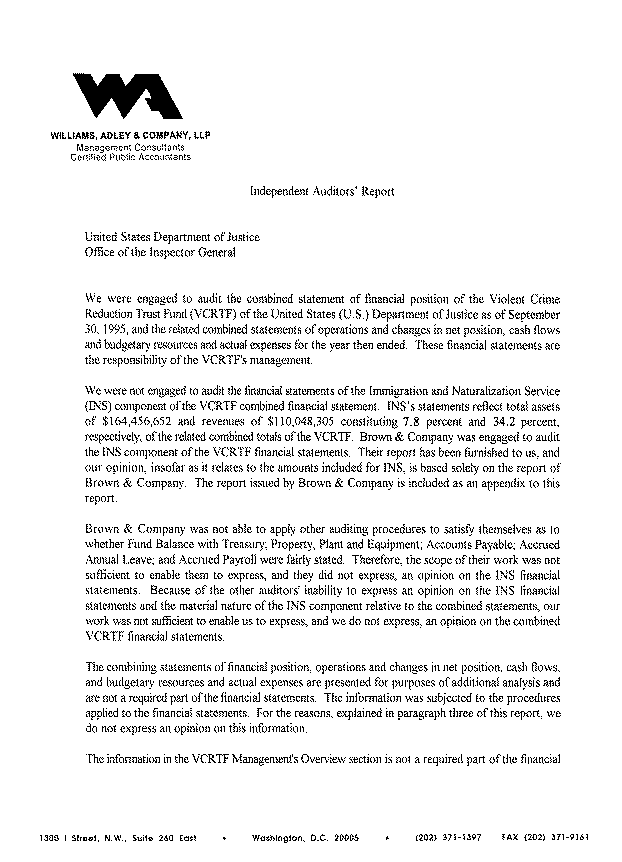
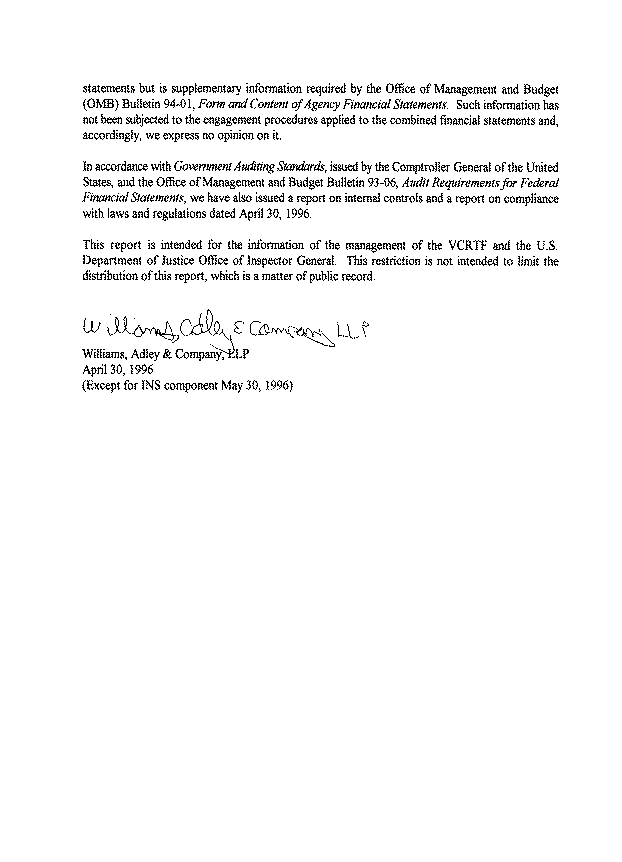
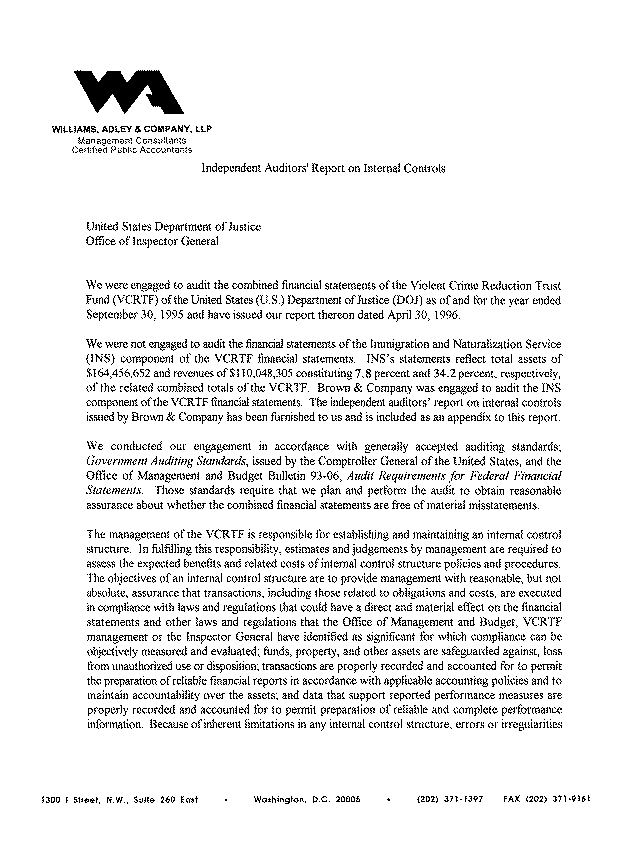
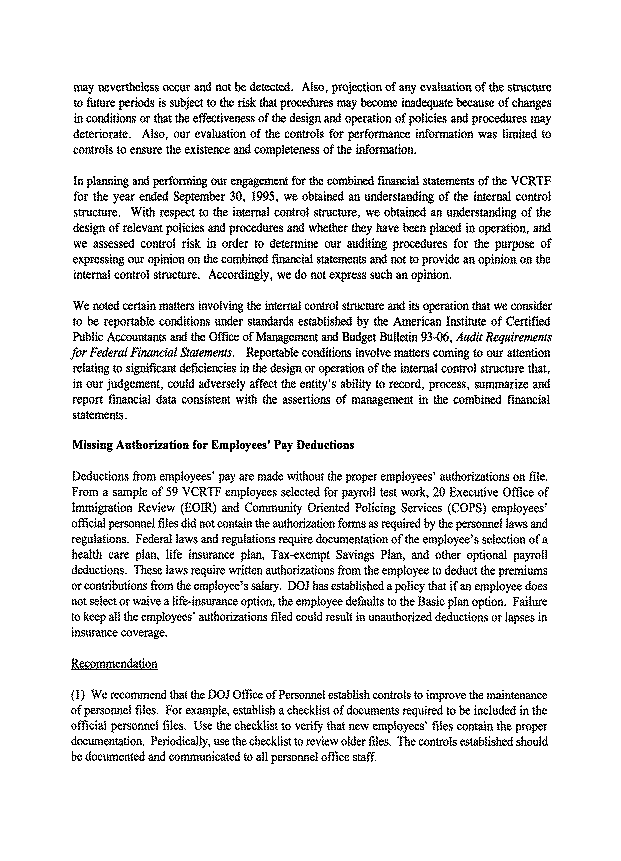

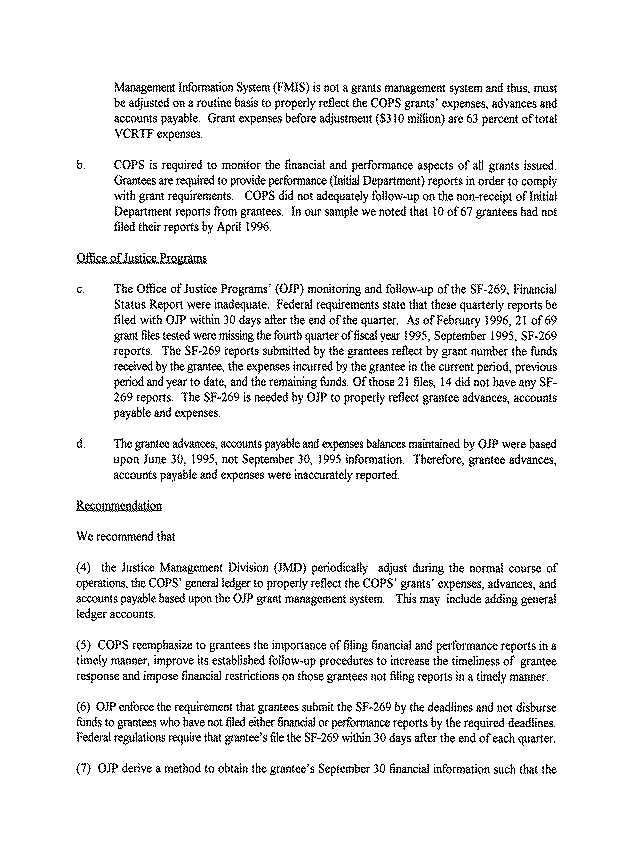

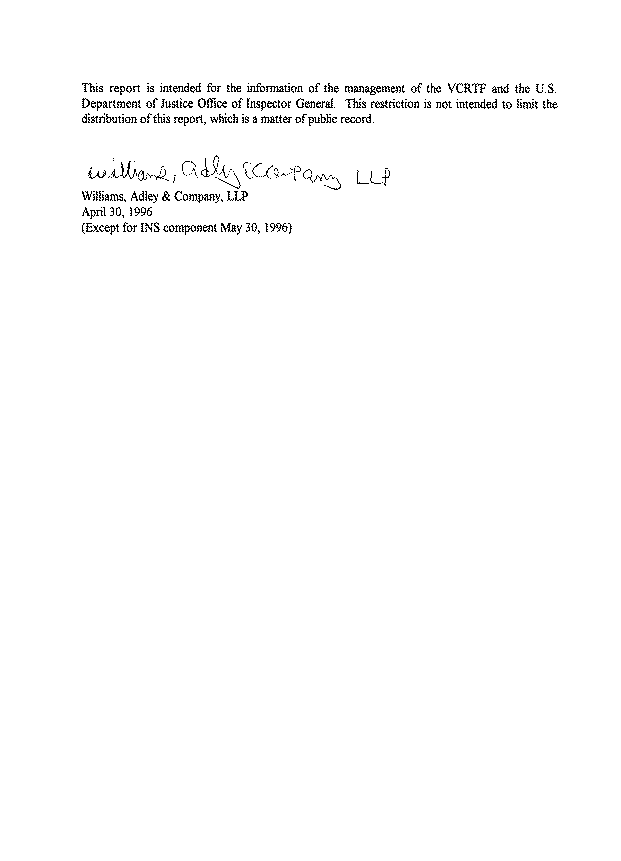
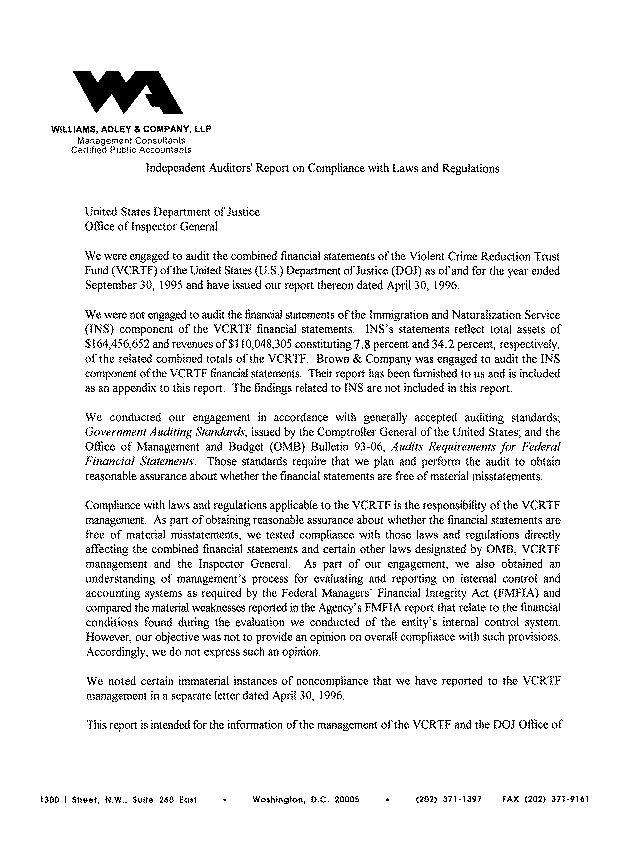

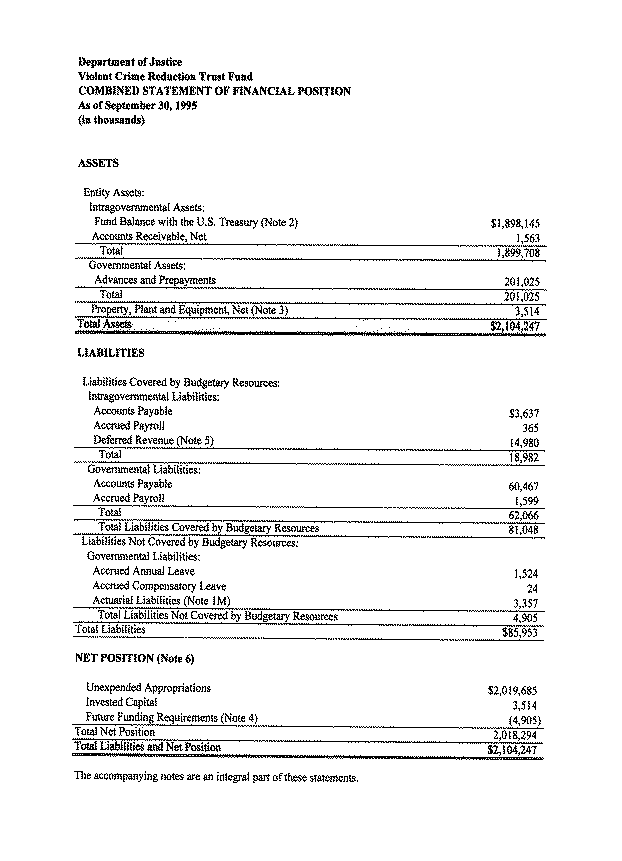
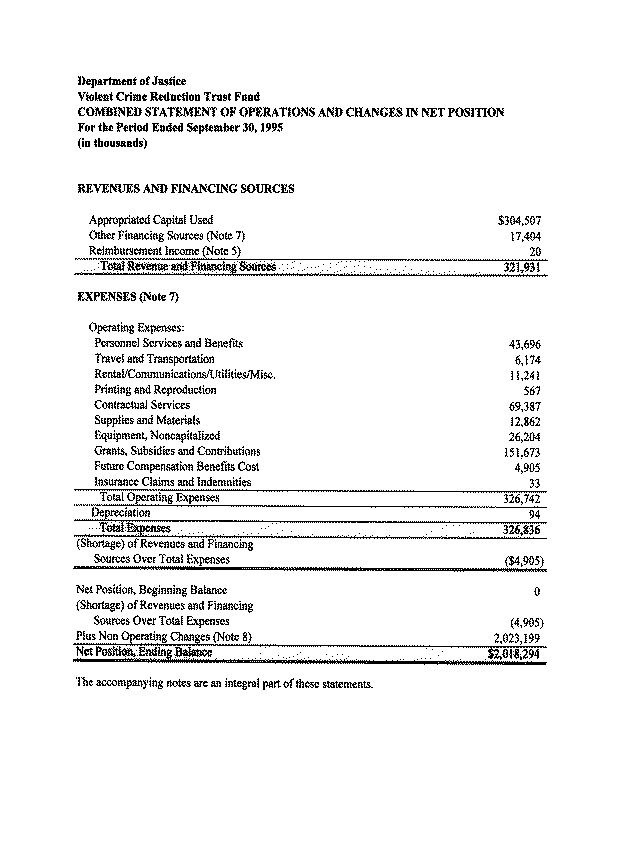
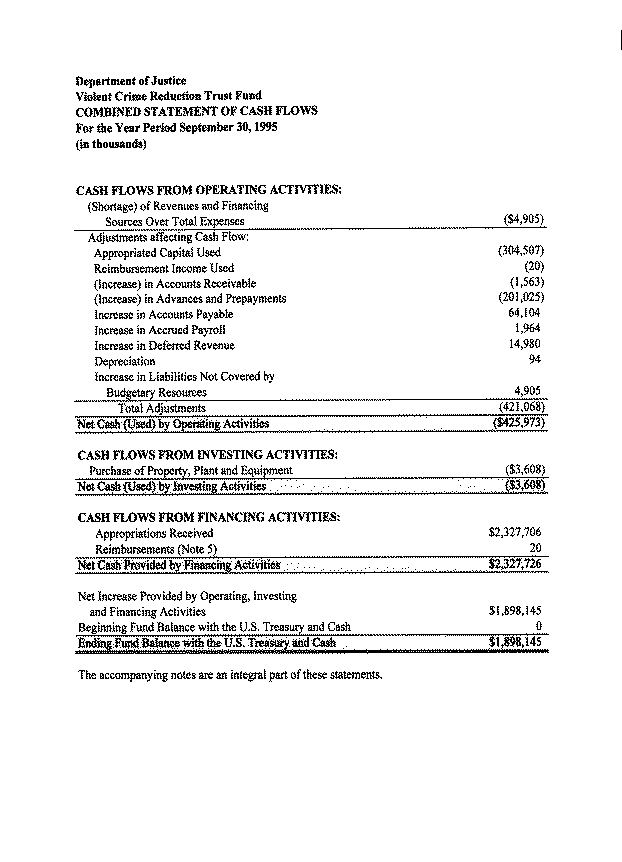
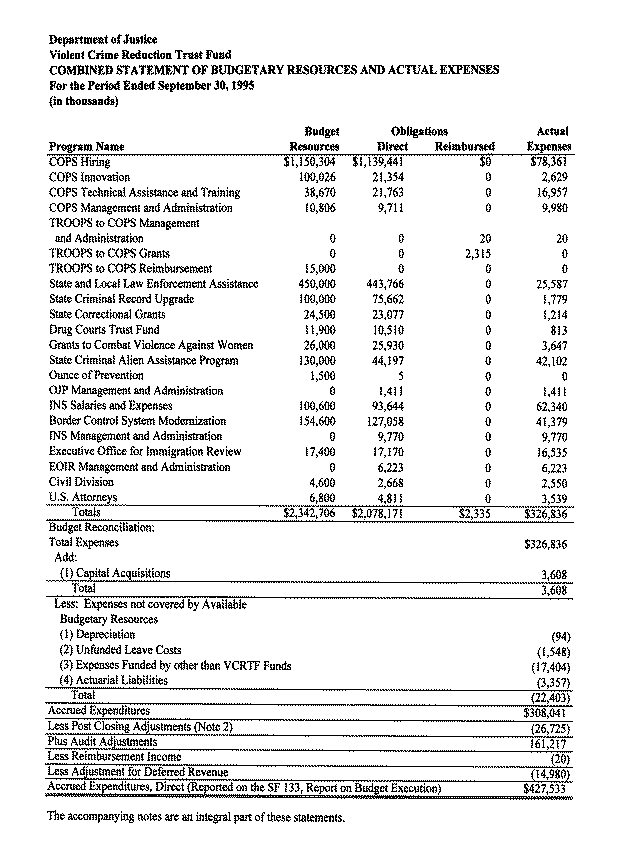
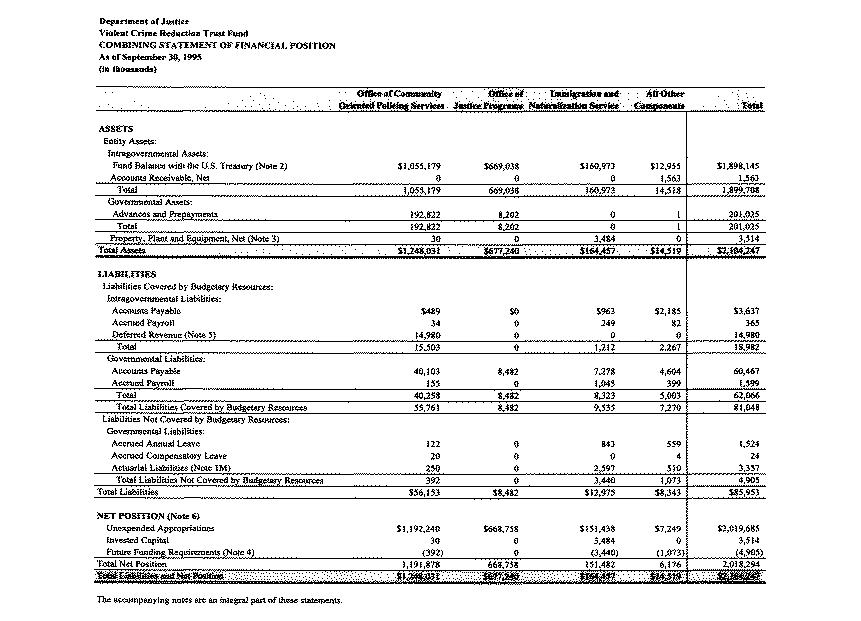
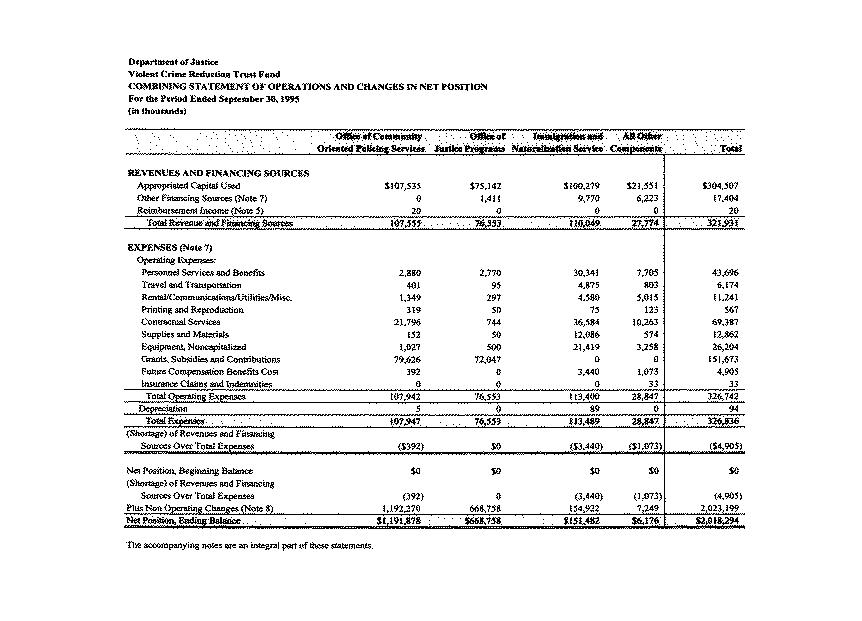
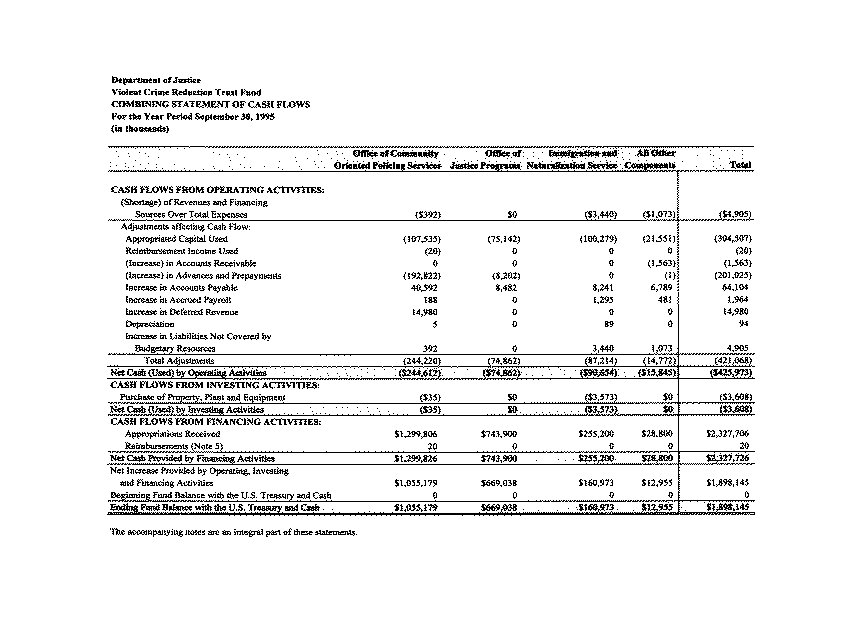
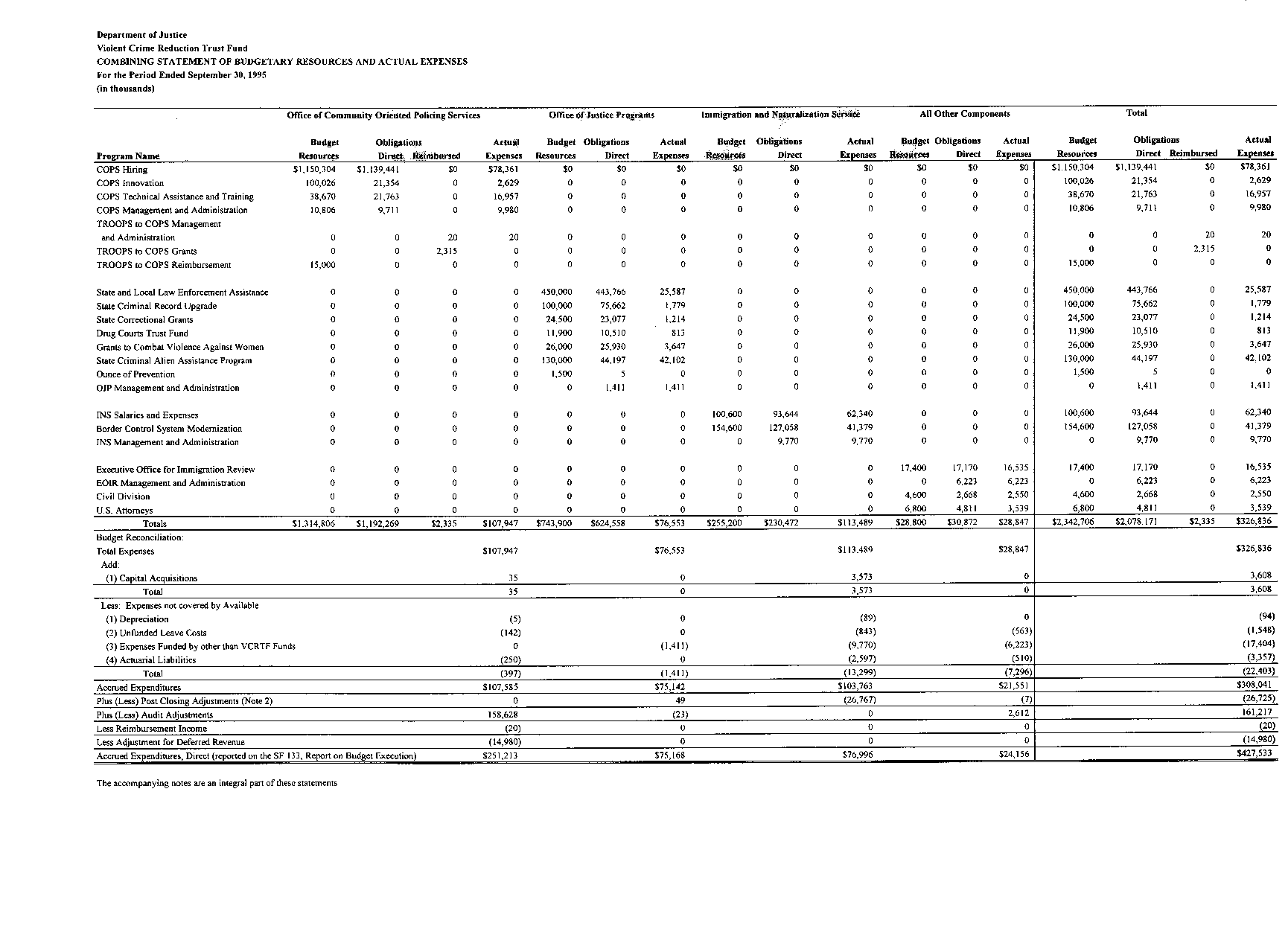
1 COPS also received $15 million from the Department of Defense
in FY 1995, to establish the "Troops to Cops" program, which provides up to
$5,000 per officer for community policing training for recently separated veterans. This
program is designed to be an incentive for COPS grantees to use their hiring grant funds
to hire qualified veterans. COPS did not receive any other non-VCRTF money in FY 1995.
2 Empowerment Zones and Enterprise Communities are areas
targeted by the Administration to receive a variety of Federal funding to revitalize the
communities.
3 Exclusion hearings are held when aliens are believed by the
INS examining inspector, at the port of entry, to be inadmissible. Deportation hearings
are held in cases where an alien's status is challenged after entry into the United
States.
#####




















